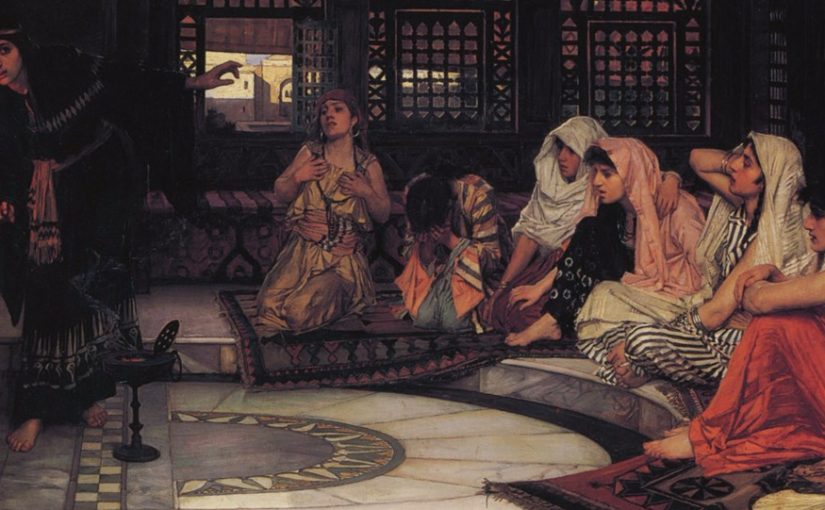It’s difficult to measure the damage that an ideology can do on a society. Often you don’t realize what a mess things are until long after the great looting, and destruction. But you can notice events. Often singular events, and often whispered about quietly. And one such event is the purging of art in favor of the formless and meaningless.
Look at the painting above. It is titled “Consulting the Oracle” and was painted by John William Waterhouse. It’s great right? It’s large. It would occupy the wall in a nice sized living room. It’s 77 inches long and 46 inches high. And it’s beautiful. Right?
This painting was very quietly sold by the museum that held it for £5 ($7.50) to a private individual.
I’ve seen cups of coffee that cost more.
The excuse is that the museum needed the money. Bills needed to be paid, and new works of art needed to be purchased to “keep the museum alive and vibrant”. Of course that old “song and dance”. The excuse, a progressive excuse, that you must destroy the old to make room for the new.
Ok.
I’ll bite.
What “new” art was worthy of purchase. How about millions of dollars for this magnificent piece…
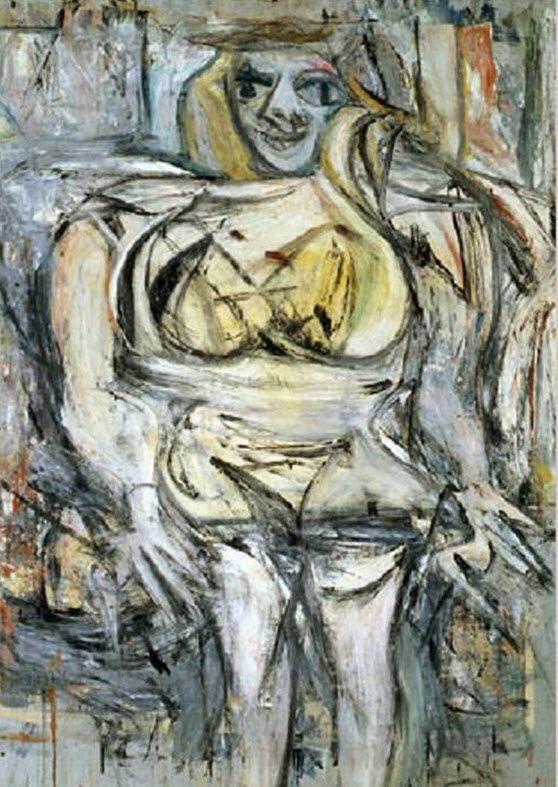
.
This undeniably strange-looking painting of a woman made Willem de Kooning and his estate a few millions richer. The painting recently changed hands to the tune of $137.5 million. This abstract painting was finished by Kooning in 1953. The painting became rather controversial in the 1970s, because it was refused for exhibit at the Tehran Museum of Contemporary Art. This painting is currently privately owned. It spans 68 inches in height and 48.5 inches in width.
Yes. I cannot believe it. Can you?
And we are not alone either…
This painting is awful. I get that it’s an abstract expressionist painting, but it is so hideous to look at. You honestly couldn’t convince me to take it if I was walking down the street and saw that laying on the grass. Clearly that means I have no taste because it sold for a ridiculous $137.5 million in 2006. This made it the 4th most expensive painting ever sold. It was created by painter Williem de Kooning in 1953. The buyer, David Geffen, is worth $6.5 billion, so nobody is going to step in and tell him how to spend his money… but are you kidding me? -10 Ugly Pieces Of Art You Won't Believe Sold For Millions
Who in their right mind made this decision?
The Art Renewal Center chimes in…
From the Art Renewal Center…
Works of art worth tens of millions of pounds today have been sold off quietly by museums over the past 50 years for a few pounds. British art institutions such as the Fitzwilliam Museum in Cambridge and the Exeter City Museum have disposed of pictures by masters such as Van Dyck and Henri Fantin Latour . They were sold without public notice, dismissed as too unimportant to keep. Among the most serious cases is a painting by the 19th-century master, John William Waterhouse . In 1965, the Royal Cornwall Museum in Truro sold it for £200 ($300) to a private collector; today it is worth more than £5 million ($7.5 million). "Most of the works were sold off as they were deemed to be artistically worthless", Christopher Wright, a leading Old Masters scholar, said. He discovered evidence of the sales while preparing a nationwide study of British art for Yale University Press. "They have been sold off without public notice," he said. "Many of the museums didn't dare make it public. They've all been proved wrong." Mr Wright expressed disbelief at the decision of the Exeter museum to "rape" its collection of 160 works - "there is no other word to describe the destruction of an entire museum collection". The auctions, which involved selling works for as little as £5 ($7.50), included Waterhouse's Consulting the Oracle, four paintings by Fantin-Latour and one by Sir Lawrence Alma Tadema . Caroline Worthington, fine art curator at Exeter, said that the sale took place at Christie's in 1954, "when High Victorian art was deeply unfashionable ... We would like them back, most definitely." "We're talking household names", Mr Wright said, adding that many were bought by the heavyweight dealers Agnews and Colnaghi, who clearly appreciated the importance of the artists, even if the museums did not. Tamsin Daniel, Truro's curator of art and exhibitions, said that the museum had needed money for storage and a lift. She conceded that the loss was painful. The Waterhouse went to a private collector bidding at Christie's. The £200 ($300) it cost him, she said, was "a bit different to what Andrew Lloyd Webber paid recently for a Waterhouse": £6.6 million ($9.9 million). Leeds City Art Gallery and Museum, Mr Wright was told by an insider, actually disguised the provenance of works when selling them through an auction house. "They were described as property of Madame X," he said. "The sales were clandestine. They didn't say Leeds was de-accessioning. They were all Victorian pictures purchased from the Royal Academy. They got rid of dozens." Nigel Walsh, curator of exhibitions, expressed surprise at the news, denying that the gallery had sold anything. Nor did Evelyn Silber, its director, know anything about it until contacted by The Times. She later discovered that 37 paintings (nearly all Victorian) had been sold in 1939 under the then director, Philip Hendey, who went on to head the National Gallery in London. The Fitzwilliam in Cambridge sold more than 200 works in the 1950s. Although they were marked "property of the Fitzwilliam" in the catalogs, they were mixed up with hundreds of other lots, Mr Wright said. "They put them through the salerooms in dribs and drabs." Mr Wright said that the Fortune-teller with Soldiers "was sold off as a copy, but it has since been published as the real thing worth millions". Craig Hartley, a Fitzwilliam curator, said: "In retrospect, this seems a horrific thing to have done." Among other institutions to have sold off paintings, Mr Wright said, were the National Maritime Museum in Greenwich; the Cooper Art Gallery in Barnsley; the Holbourne Museum of Art in Bath; and the Birmingham City Art Gallery. -Art Renewal Center article by Dalya Alberge
I am horrified.
Just beyond my self.
So who ended up getting these magnificent works of art?
"They were described as property of Madame X," he said. "The sales were clandestine. They didn't say Leeds was de-accessioning. They were all Victorian pictures purchased from the Royal Academy. They got rid of dozens."
Well, you must understand that a museum collects works of art for pubic display and enjoyment. If they no longer wants to display that art to the public, they take if off display and put it in storage. Apparently these works took up too much space, so they sold them to “Art Dealers”. And these art dealers held auctions and auctioned them off to wealthy attendees.
Yes.
That’s right. The art was taken away from public display and sold off to the oligarchy for their own personal use.
What has been going on…
Get the entire picture. From a speech by Fred Ross at the Art Renewal Center…
Ladies and Gentlemen ... Artists,
The art of painting, one of the greatest traditions in all of human history has been under a merciless and relentless assault for the last one hundred years. I'm referring to the accumulated knowledge of over 2500 hundred years, spanning from Ancient Greece to the early Renaissance and through to the extraordinary pinnacles of artistic achievement seen in the High Renaissance, 17th century Dutch, and the great 19th century Academies of Europe and America. These traditions, just when they were at their absolute zenith, at a peak of achievement, seemingly unbeatable and unstoppable, hit the twentieth century at full stride, and then ... fell off a cliff, and smashed to pieces on the rocks below. Since World War I the contemporary visual arts as represented in Museum exhibitions, University Art Departments, and journalistic art criticism became little more than juvenile, repetitive exercises at proving to the former adult world that they could do whatever they damn well wanted ... sadly devolving ever downwards into a distorted, contrived and contorted notion of freedom of expression. Freedom of expression? Ironically, this so-called "freedom" as embodied in Modernism, rather than a form of "expression" in truth became a form of "suppression" and "oppression." Modernism as we know it, ultimately became the most oppressive and restrictive system of thought in all of art history.
Every reasonable shred of order and any standards with which it was possible to identify, understand and to create great paintings and sculpture, was degraded ... detested ... desecrated and eviscerated. The backbone of the painters' craft, namely drawing, was thrown into the trash along with modeling, perspective, illusion, recognizable objects or elements from the real world, and with it the ability to capture, exhibit, and poetically express subjects and themes about mankind and the human condition and about man's trials on this speck of stardust called Earth ... Earth, hurtling through infinity with all of us along on board, along with everything we know and everything we hold dear.
Reason ... philosophy ... religion ... literature ... fantasy ... dreams, and all of the feelings, emotions and pathos of our every day lives ... all of it was no longer worthy of the painter's craft. Any hint by the artist at trying to portray such things was branded as banal, maudlin, photographic, illustration, or petty sentimentality.
Our children, going supposedly to the finest universities in the world, being taught by professors with Bachelors or Arts, Masters of Arts, Masters of Fine Arts, Masters of Art Education ... even Doctoral degrees, our children instead have been subjected to methodical brain-washing and taught to deny the evidence of their own senses. Taught that Mattisse, Cézanne, and Picasso, along with their followers, were the most brilliant artists in all of history. Why? Because they weren't telling us lies like the traditional painters, of course. They weren't trying to make us believe that we were looking at scenes in reality, or at scenes from the imagination, from fantasy or from dreams. They were telling us the truth. They were telling it like it is. They spent their lives and careers on something that was not banal, and not silly, insipid or inane. They in fact provided the world with the most ingenious of all breakthroughs in the history of artistic thought. Even the great scientific achievements of the industrial revolution paled before their brilliant discovery. And what was that discovery for which they have been raised above Bouguereau , exalted over Gérôme , and celebrated beyond Ingres , David , Constable , Fragonard , Van Dyck , and Gainsborough or Poussin ? Why in fact were they heralded to the absolute zenith ... the tiptop of human achievement ... being worthy even of placement shoulder to shoulder on pedestals right beside Rembrandt , Michelangelo , Leonardo , Caravaggio , Vermeer and Raphael ? What did they do? Why were they glorified practically above all others that ever went before them? Ladies and gentleman, they proved ... amazing, incredible, and fantastic as it may seem, they proved that the canvas was flat ... flat and very thin ... skinny ... indeed, not even shallow, lacking any depth or meaning whatsoever.
And the flatter that they proved it to be the greater they were exalted. Cézanne collapsed the landscape, Matisse flattened our homes and our families, and Pollock, Rothko and de Kooning placed it all in a blender and splattered it against the wall. They made even pancakes look fat and chunky by comparison. But this was only part of the breathtaking breakthroughs of modernism ... and their offshoots flourished. Abstract expressionism, Cubism, Fauvism, minimalism, ColorField, Conceptual, op-art, pop-art and post modernism ... and to understand it all ... to understand, took very special people indeed, since the mass of humanity was too ignorant and stupid to understand. Like that famous advertisement in the NY Times said so many years ago ... Bad art ... or Good art? You be the judge, indeed.
Of course, to justify this whole theoretical paradigm, all the artists that painted recognizable scenes with depth and illusion had to be discredited ... and discredited they were, with a virulence and vituperation so scathing and merciless that one would think they must have been messengers of the devil himself to deserve such abuse. And to put the final nail in their coffins, all of their art was banished and their names and accomplishments written right out of history. I graduated with a Master's in art education from Columbia University, and I'd never heard of Bouguereau , much less that he was President of the Academy and head of the Salon ... the most celebrated artist of his time who single handedly, using all of his influence as the most respected leader of art world, opened up L'Ecole Des Beaux Arts and the Salons to women artists for the first time in history.
During most of the 20th century, the type of propaganda that has been hurled at academic artists is so insidious that people have been literally trained to discredit, out-of-hand, any work containing well-crafted figures or elements, or any other evidence of technical mastery. All the beauty and subtlety of emotions, — interplay of composition, design and theme, — the interlacing of color, tone and mood, — are never seen. The viewer has been taught that academic painting on a prima facie basis is bad by definition — bad by virtue of its resorting to the use of human figures, themes or stories and objects from the real world.
Prestige suggestion causes them to automatically assume that a work must be great if it's by any of the "big names" of modern art, so they at once start looking for reasons why it must be proclaimed great. Any failing to find greatness is not considered a failing in the art but in the intelligence and sensibilities of the viewer. Students operating under that kind of intimidating pressure, you can be sure, will find greatness - no matter what they are looking at.
The reverse of this has been trained into them when they view academic paintings. They have been taught that works exhibiting realistic rendering are "bad art" and therefore any good that is seen is not due to qualities inherent in their artistic accomplishments, but are rather due to a lack of intelligence and taste in the viewer. The same intimidating pressure works in reverse to ensure that a work by Bouguereau , Lord Leighton , Burne-Jones , Gérôme , Frederick Hart , or any of the rest of you here, will not be seen as anything other than bad by definition.
No student in a school with this kind of dictatorial brain-washing will ever risk exploring or even listening to opposing views, for fear of being stigmatized from that point on, with some undesirable label and being universally despised ... sadly, a very effective deterrent to independent thought. Thus the visual experience of well-drawn representational elements is perceived as a negative, ad hominem, that proves with knee-jerk automaticity the presumed "badness" of the art and its creator.
It is especially ironic that these are the same people who trumpet the virtues and inalienable right to freedom of speech, while they surreptitiously and steadfastly conspire to remove that freedom from those with whom they disagree.
Equally ironic is the charge that academic painting is "uninspired," a proclamation issued by critics who are unable to see beyond the technical virtuosity for which they condemn it, to see what is being said. This rich visual language is wasted on eyes that will not see. It would be no different than dismissing out-of-hand a piece of music as soon as it was determined that notes, chords and keys were used, or dismissing any work of literature upon noticing words arranged in grammatically correct sentences.
That is not to say that all academic art is great, or above criticism - certainly, it is not. It would be no less fallacious to issue blanket praise to an entire category than to condemn it. Academic painting ranges from brilliantly conceived and deeply inspired, to trite and silly, depending on the subject and the artist.
That being said, I find even the worst of it more meaningful than art based on the ridiculous notion that it is somehow important to prove the canvas is flat, and/or that one needs no skill or technique to be an artist - views generally embraced by those who condemn the entire category of academic art. Their point seems to be to elevate to legitimacy that which has removed all standards and prior defining characteristics of art. In other words, by defining non-art as art, the logical conclusion is that art is non-art.
Modern artists are told that they must create something totally original. Nothing about what they do can ever have been done before in any way shape or form, otherwise they risk being called "derivative". How utterly absurd.
These critics like to say Bouguereau's work is really only derivative, harking back to earlier artists. Only in the 20th century has such a thing ever been scorned. To this I have one thing to say:
What, dear friends, is wrong with being derivative?
That's one of the core beliefs of modernism that must be soundly vanquished by common sense and logical analysis. Nobody can accomplish anything of merit if they are in fact not derivative. Only by mastering the accomplishments of the past and then adding to it can we go still further. Every other field of endeavor recognizes this truth. Without the knowledge of the past we are doomed to everlasting primitivism.
And, as far as holding our works up to the old masters, that's what we want to have happen. If we are to accomplish things of true merit and excellence, we must germinate and nurture great masters in the next millennium, too. Bouguereau was quite aware that his work would be compared on the altar of past accomplishments, as did his contemporaries. It was precisely because they mastered the techniques of the past, built upon them and then opened them up to an avalanche of new subject matter and Enlightenment ideals, that they accomplished the greatest half-century of painting in art history.
And when we talk about the basic criteria and parameters of the academic tradition that built from the 14th through 19th centuries, Bouguereau , Lord Leighton and Alma-Tadema were second to none.
Could Bach and Beethoven and Mozart have achieved their masterpieces if someone before had not discovered scales and the circle of fifths? Does that mean these musical giants were nothing but derivative too? In fact all great literature exists due to the existence of advanced language. This upside down thought process would make Dosteovsky, Balzac, Chekhov, Shakespeare and the Brontë sisters derivative as well. If you think about it a bit you will see that these are exact analogies. There is nothing any more derivative about these 19th century Traditional-Humanist-Academic masters.
Being derivative is entirely different from copying. Copying itself can have value, but only for the purposes of instruction. Obviously, a copied work is not original art. But modernist ideologues have disingenuously dismissed all realist art as "derivative" as if that were the same as copying.
Additionally, students today are taught that every parameter upon which any standard for quality and excellence can be deduced is improper, because it's "limiting to freedom of expression."
There can be no story, for then you have to stay within the "tight boundaries" of the tale.
There can be no illusion, for then you are "chained" by the need to recreate a sense of three dimensions.
There can be no drawing, as that can be "limiting" to objects or people or things taken from the real world.
They want to remove the "shackles" of modeling, perspective, or subject matter of any sort.
There certainly can be no attempt at harmonizing of the above parameters with composition, color and tonality, for that would "restrict" one to making everything work together.
On the contrary, they have been propagandized by modernism into believing that only those works that break boundaries, ignore standards, and show no interest in skill or technique can be truly "original" or "inspired." In fact originality of methods take precedence over all else. If something has been done before, or is derivative in any way of anything that was done before, it thereby loses value proportionate to those similarities. In such a "Through the looking glass" world, every would-be "artist" is placed in the untenable position of trying to create an entirely new art form in order to be considered relevant. The sheer glaring reality is that nothing could be more imprisoning, binding, restricting, chaining and shackling than the impossible limitations of modernism and post-modernism, that remove from the would-be artist every tool (including training) that could give him or her the ability to create great works of art. The simple truth is that each and every one of us (and I mean nearly every human being), is capable of thinking of something that has never been done before. Does that make it worth doing and the work of genius?
For example:
(1) I could carefully (with enough money) dig up an old bombed out tenement building in the Bronx, and have it transported to a special slab built for it in Central Park. Rope off the structure and aim lights at it at night and give it a title, and with enough pomp and circumstance think of twenty reasons why this is sheer brilliance and genius.
(2) I could boil the entrails of several different animals and then preserve them by imbedding them in clear plastic. I could then hang them from a mobile with similarly preserved body parts of cadavers, and have critics claim that this is the greatest artistic statement about the horrors of war since Guernica
(3) I could imbed into the walls, ceiling and floors of a small room, pieces of neon lights, parts from broken machines and engines, and broken pieces of structural building materials like bricks, beams and cinder blocks. Then I could glue between everything millions of nails, nuts and bolts, and have clever writers and critics point out how this room (which could be installed at MOMA or the Guggenheim) is the quintessential statement of the effects of the industrial age on human psychology.
Well, those three ideas took all of 3 minutes to think of. MY GOD! This must mean I'm three geniuses rolled into one. Why, at this rate I could come up with more brilliant ideas for Modernism than all of the modernist geniuses put together, if I just would put aside a week or two.
The thing here that really is interesting is not their art at all, but the statement it makes about the nature of our species — that so many seemingly intelligent people have been so easily snookered by the tongue-twisting, convoluted illogic of modernist rhetoric. Clearly for many people it is more important to feel that they are some part of an elitist in-group that is endowed with the special ability to see brilliance where the bulk of humanity sees nothing and is afraid to say so.
Since most people aren't devoted to or educated in fine art, they have successfully intimidated the bulk of humanity into cowering away in silence, feeling foolish for their inability to understand. The average person shrinks away from believing the reality of his or her own senses in the face of seemingly overwhelming numbers of people in this 20th century "establishment" who authoritatively dictate what is great art and what everyone should be seeing.
Modern and Post-modern Art is nihilistic and anti-human. It denigrates humanity along with our hopes, dreams, desires and the real world in which we live. All reference to any of these things is forbidden in the canonistic halls of modernist ideology. We can see that their hallowed halls are a hollow shell, a vacuous, vacant vault that locks their devotees away from life and humanity. It ultimately bores the overwhelming bulk of its would-be audience, who can find nothing with which to relate.
It has been called exciting and cutting-edge, but the sad truth is that it is incredibly humdrum and monotonous. Whether you glue together pieces of plastic or shards of glass, assemble metal scraps or piles of feathers. Whether you dribble little dollops of colors or drag fat uneven slashes of black. Whether you compile a mountain of paper or wrap the Statue of Liberty. The effect is always the same. MEANINGLESS PRIMITIVISM.
Modernism is art about art. It endlessly asks the question, ad nauseam: What is art? What is art? Only those things that expand the boundaries of art are good; all else is bad. It is art about art. Whereas all the great art in history, my friends, is ART ABOUT LIFE.
Of course, this isn't exactly the first time in history that ideas which were complete shams managed to engulf the belief systems of entire cultures and civilizations. In many of those in the past, the lunacy was enforced by the severest of punishments for anyone who would dare to speak out.
At least we live in a time and place where it's possible to speak against this consummate con that has been perpetrated against the greatest period of artistic development and achievement in the history of Western Civilization and culture over the last 500 years.
Three-quarters of the 20th century will go down in art history as a great wasteland of insanity — a nightmarish blip in the long road of the development of human logic and reason and art, from which we are only just starting to awake.
The artists of the 19th century exhibited a deep, abiding respect for humanity and human feelings. A respect for our minds, our spirits and our reason, and a love of beauty, grace and true excellence and accomplishment. Bouguereau , Lord Leighton , Waterhouse , Burne-Jones and the other giants of the 19th C. tried to capture those things that are good and decent in our species. Their accomplishments are the quintessential high point of hundreds of years of human study and development in the art of painting. They are arguably the greatest painters that history has ever produced. Bouguereau especially fits this description. How fitting and sadly obvious that he should be characterized as the chief villain by those who would destroy rather than build — who celebrate chaos rather than order and beauty.
He continues…
Recently, a contributor to an on-line art forum I subscribe to made the following comments about Picasso,
I love the way Picasso did that woman all shards and angles. I don't recall the name of the work. But, he painted the woman in her turmoil how she tore herself apart within, and how he saw what her turmoil did to her. He painted the way he saw her, as fragmented as he saw her. She was a beauty on the outside. Yet, he painted the ugly face of her turmoil, and in so doing painted his turmoil as well.
Picasso worked in a turbulent time. I think it's why some of his works appeared to be reflections in a broken mirror. Shards, impressions all cut up and each with a voice about his subjects and of Spain. His work shows a deeply sensitive artist and was a pivotal point for the Russian avant garde school that said it was okay to feel in paint, to get all the chaos out in paint ... I didn't love him until I studied him ...
- Laurie
And he continues…
I thought it fitting to read here my response to her.
Laurie and Goodart subscribers,
I really need to address these ebullient expressions of praise for Picasso a bit more precisely.
Laurie, this is not to fault you at all, but to analyze the description you have made which reflects the gospel that is taught about him in most art history courses. His name and "achievements" have become so "untouchable" within the sacrosanct walls of modernist cathedrals, that to do any other than you have stated here would be like criticizing the cross or the bible in the College of Cardinals.
Let's look at this one idea at a time.
You said that, "He painted the woman in her turmoil how she tore herself apart within, and how he saw what her turmoil did to her".
I
n fact, all that he painted was a messy characterization of a woman in which the forms and shapes don't align or create any cohesive form. The drawing is virtually non-existent, and the disintegration of all artistic elements are self-consciously laid out for the express purpose of rejecting prior artistic standards.
There is no beauty in her face, or for that matter, ugliness. There isn't even a face ... but elements thrown together with just enough evidence to let the viewer know that it was meant to suggest a face.
Everything about the finished product is utterly awful and would be beneath the capabilities of a talented 12 year old.
Now, what if you are a theorist who needs to justify this hodge-podge of sloppy color and form? What can you creatively think of to place value and meaning, where none exists ... especially, if you are being paid to do just that?
It's simple: you need but approach the work as you would a Rorschach inkblot test, where anyone can use creative ability to make up a story, suggested by little, if any, information. If you want this man's work to be valued highly, you must create a tale of great importance, with meaning, which, when discussed or analyzed in intellectual circles, will be considered profound and meaningful.
The idea of a lady being ugly on the inside is a concept from literature, psychology, and in fact all of human history. Ugliness, mean-spiritedness, and turmoil are major concepts that tint all of human experience. So you simply say that the messiness represents that, and look how brilliant he is to have captured it.
But in truth he has done nothing of the kind. The writers who said that was what it means were the one who did it, and not the artist. Inner turmoil and ugliness on the inside is far more difficult to capture, and takes intense, subtle handling of story telling, composition, drawing, and realistic rendering to successfully convey so that it can be recognized without any words. Waterhouse's Lady of Shalott and Bouguereau's Divideuse both capture beautiful women loaded with inner turmoil, and Cabanel's Cleopatra testing poisons on slaves portrays intense inner ugliness within a beautiful face and figure infinitely better than these broken blotchy messes on canvas by Picasso.
But when the modernist professors say that's what it means, then implicit in their words is that if you don't see it too you're stupid and tasteless. Also to not see it becomes associated with not seeing how wonderful that subject matter would be. And it is after all truly wonderful subject matter. Only one problem; Picasso didn't paint it.
You say, "his work shows a deeply sensitive artist," but I don't conclude any sensitivity whatsoever. What is there is the sensitivity of a bull in a china shop, who stomps around breaking all the beautiful porcelain, and then with an army of critics lined up with their nostrils flaring dares anyone to criticize the dump he just left in the your living room.
"Either you love my turds or you are against freedom of expression."
If you don't want it in your museum, you're the enemy of freedom of speech. Faced with such intimidation surely many would rather line up in support. But there is truly nothing there. It's a trick of words and intimidation. An Illusion of social pressure and fearful conformity.
His school, "... said it was okay to feel in paint, to get all the chaos out in paint ... I didn't love him until I studied him."
Of course you didn't love him until you studied him. What you learned to love was all the explanations about worthwhile concepts and subjects. And with a training right out of Pavlov, you were taught to salivate when you were shown things that caused associations to those worthwhile ideas.
But Laurie, WHERE'S the BEEF? You're salivating at a symbol much the way people react to their country's flag. The flag comes to be seen as beautiful because it represents family, home and hearth, friends, loyalty, and the things we love. You've been taught to react to symbols instead of responding with the freedom of independent thought to works of art that are not supposed to be flag-like-symbols of great artistic ideas, but the great works of art themselves, which communicate, through a readily discernable visual language, some aspect of the human condition.
You had to be taught to love Picasso, because nobody would love him otherwise. But people don't need to be taught to love Rembrandt , Michelangelo , Bouguereau , or for that matter Chopin, Beethoven, Bach, or Tom Sawyer, The Grapes of Wrath, Alice in Wonderland, or The Christmas Carol.
Teaching and information can add to the depth of understanding of great works of art, but they are great initially by their ability to capture the soul and imagination of the viewer, without thousands of words to instruct us on how to deny the evidence of our own senses and to deny our innate sense of truth and reason.
Of course, what tends to happen to people who have allowed themselves to be convinced that the emperor is wearing beautiful clothes, is that they have become "ego invested" due to years of having parroted the same falsehoods ... and the associated humiliation that goes with acknowledging that one has been had. The more years, and the more said in support of Modernism, the greater the difficulty in breaking through the gestalts, and taking off the iconic blinders, shedding all the preconceptions and looking again with "innocent eyes" and describing what is really there (at least to yourself), and then comparing it to the maligned academics like Waterhouse , Bouguereau , Lord Leighton , Burne-Jones , Gérôme , and Alma-Tadema , and deciding with freedom of thought and an honest wish to find the truth, which of them indeed are works of art, and which are snake oil salesmen."
He continues…
And so I ended that letter.
The change in people's perceptions about this is happening now very quickly. Even this austere institution, probably the greatest museum in the Western Hemisphere, just a couple of summers ago had a major retrospective of one of these maligned 19th century masters, Edward Coley Burne-Jones.
And in their literature on the show declared him one of the three greatest English artists of the last century, along with Constable and Turner. In fact, the Metropolitan Museum deserves great credit for being one of the first great institutions to once again hang their Bouguereaus and Gérômes, Meissonnier and Burne-Jones, on permanent exhibit in the face of scathing criticism from the press back in 1980.
Soon after, Laurie followed this with a good-natured post saying that although she felt that I may have insulted her intelligence, she loved me all the same. To which I responded:
And …
Laurie,
It was not my wish to insult your intelligence. The very brightest of people are just as vulnerable. It is in human nature to go along to get along. I certainly did it too when I was in college and grad school in fine art. Even when I was finally willing to speak my mind about Pollock, de Kooning, Rothko and Warhol .... Picasso was somehow sacrosanct, and I would pay lip service to his brilliance while the works of the other modernists I allowed myself to see as they were.
It wasn't until I hit about 40 years old that I started to more fully recognize the power of prestige suggestion and social intimidation in forming opinions.
To truly judge your own feelings and opinion about a work of art, you need to look at it as if it were painted by a complete unknown, perhaps some student in another town, and then ask yourself what your opinion of that work would be then. Would you think it was one of the greatest works in the history of civilization, would it even be great ... or good ... or mediocre .... or just plain bad?
So true.
He continues further…
I know now absolutely that nearly all the works by most of the famous Modernists are truly awful on all fronts. I also know that the best works by Bouguereau and Waterhouse would thrill me to my bones even if they had been painted by complete unknowns. When I saw a Bouguereau for the first time, I had never heard of him, but my response was immediate unambiguous and self-validating. I needed no books or texts or convoluted explanations. The strength of the work was powerful, unique, immediate and overwhelming. It was exactly as I had felt in the presence of Michelangelo's David. Ah, but when I saw the David I was already predisposed to see what history considered one of humanity's greatest masterpieces. However, it was that seminal experience at 18 that excited my interest in art. The Bouguereau that I saw, Nymphs and Satyr, was when I was 32 years old, and it's effect was equally profound, changing the course of my life, ultimately leading me to this podium here today. Don't let pride get involved here. Don't even answer me. Just ask yourselves and answer honestly. One common claim that you hear repeatedly is that the proof that some abstract expressionists were great artists, can be found in their high quality academic student drawings. My answer to this is that it's really irrelevant whether or not they could do a decent student drawing. If anything it only makes it sadder that promising young talent was wasted. The quality and value of their "mature" work is not helped a bit by showing that they could draw decently when young. The best way to prove that is to consider the inverse. Would Raphael or Bouguereau's mature work be somehow made the worse if their student drawings from decades earlier had been of poor quality? Their great paintings would still be just as great, and de Kooning's hideous smears for which he is so famous are still just as awful. I am quite certain that every artist in this audience paints better than all of the famous modernists and post modernists, and is more deserving of societal attention and praise. Yet still, so-called "major works" of theirs can sell for between 2 and 25,000,000 dollars at auction. The dirty little secret, however, that the modernist establishment and the press has been hiding, is that those same works sold for two to three times those prices back in 1988 and 1989. While the prices of all the icons of modernism peaked at that time, and any money invested then has declined a whopping 50 to 80%, the market for Gérôme , Waterhouse , Bouguereau , Alma-Tadema , Burne-Jones , Rossetti , Millais and Lord Leighton , has increased between 2000 and 10,000 percent since 1975. Every year, records are being broken again and again. In 1977, the world record price for a Bouguereau was $17,000. Now, in the past 3 years, the world records for his work first topped a million dollars in 1997, then a million and a half in 1998, two and a half million in 1999, and last May, Charity sold for over $3,500,000. Additionally, last June the world record for any Victorian painting was completely trampled when Saint Cecilia, by John William Waterhouse, sold for just over $10,000,000 in London to Andrew Lloyd Weber. There are only 826 Bouguereaus and about 465 Tademas in the world. Do you know how many Picassos there are? Can anybody here guess? There are 80,000 of them, and the balance between supply and demand has faltered, and like the dot com stocks of last year they will soon come crashing down along with hundreds of billions of paper profits lost in the dust of history. Like the tulip bulbs in the 17th century, or Tokyo Real estate in the 1980's, investors will be decimated. If I owned a work by any of those "Abstract artists" I would be racing to cash it in before the fall, and that has been my recommendation to dozens who have asked me. Many of my friends in and out of ARC have told me that I shouldn't talk so much about the modernists. One of them recently wrote to me saying, "I really don't think we help our cause by helping talentless modernists get press coverage." Another fearfully said, "Don't criticize the modernists, just focus on what's good." I replied as follows:
His reply…
When have the modernists ever held back from criticizing traditional and academic art? The problem with this attitude, while I also find it very appealing, is that our not talking about the modernists doesn't really mean much.
The fact is that they are being talked about with high praise, in nearly every university art department and art history course in the western world ... parroting the same things that they were taught. They are also being constantly celebrated and exhibited by the biggest and most prestigious museums and getting rave reviews in the newspapers as often as not.
If somebody doesn't explain to everybody why they're not really any good, and why they're not really even artists, and how the whole thing is a hoax, then they will continue their propaganda and continue brainwashing our children and intimidating them into feeling stupid if they don't go along to get along ... and they'll do it unopposed.
If we don't speak up and tell the world that the Emperor's naked, nobody else will. We may not want to talk about them, but we have to if we are going to have any chance of turning things around. We have to provide a theoretical and philosophical context for the feelings of the tens of millions of people out there who are disgusted and feel an aversion for Modernism ... but feel afraid to say so. They need to know that they are not alone and they need to have their feelings validated. And at the same time, we need to provide alternatives ... rich alternatives with great traditional art and with countless images of the greatest paintings in history.
So well put…
And now ladies and gentlemen ... artists ... portrait artists ... I come at this point ... to you. Who are you? Who do you think yourselves to be? Well let me tell you how I see you. You are beyond doubt, the true artistic heroes and heroines of the 20th century. Many of you know that I am the chairman of the Art Renewal Center, which you can find at http://www.artrenewal.org. The Art Renewal Center is building the largest on-line museum on the internet, and is completely devoted to the return of standards, training and human themes and subjects in the visual arts. Modern Art is about expanding the definition of art. They believe that "everything is art", or, "Whatever the artist says is art, is art." Well, if everything is art, then nothing is art. Any definition that includes everything is not a definition at all. As I said, Modern art is "art about art", while all the great art and literature and theatre throughout history is "Art about life." I wrote about all of you, and your teachers, in the published Philosophy of the Art Renewal Center. Here's what I said: Against all odds, and in the face of the worst kind of ridicule and personal and editorial assault, only a small handful of well-trained artists managed to stay true to their beliefs. Then, like the heroes and heroines who protected a few rare manuscripts during inquisitional book-burnings of the past, these 20th Century art world heroes managed to protect and preserve the core technical knowledge of western art. Somehow, they succeeded in training a few dozen determined disciples. Today, many of those former students, have established their own schools or ateliers, and are currently training many hundreds more. This movement is now expanding exponentially. They are regaining the traditions of the past, so that art may once again move forward on a solid footing. We are committed in every way possible to record, preserve and perpetuate this priceless knowledge. That's who you are. So if some of you are having trouble selling your work, or haven't been able to command the prices you deserve ... if you feel infuriated at piles of bricks and elephant dung filling museum galleries, while you can only pay to have space allotted to you for an evening in a great museum like this ... don't despair. Your time is coming. You have done humanity a service of such magnitude, that sadly you will never be properly repaid. Keep painting your great portraits, and when you can find the time, paint what your heart tells you to paint, too. The modern world is a boiling cauldron of all sorts of great and absurd ideas, feelings, pathos, pathologies, psycho pathologies, humiliation, and dehumanizing ideas ... and yet ... yet even beauty, too, is still here amongst us, here in this hall and throughout the world, and her manifestations in modern times have been insufficiently expressed. So, find her in your homes, find her in the streets, find her in your communities and in nature, and especially, find her in each other ... and save her ... save her ... protect and cherish her ... and exalt her back to her rightful place ... a place of supreme prominence, and bring her back into these our greatest institutions and our highest citadels of society and culture. Thank you.
So inspiring.
Here’s one of my lost paintings. Destroyed by the “new” America that exists for the few; the oligarchy that controls all.
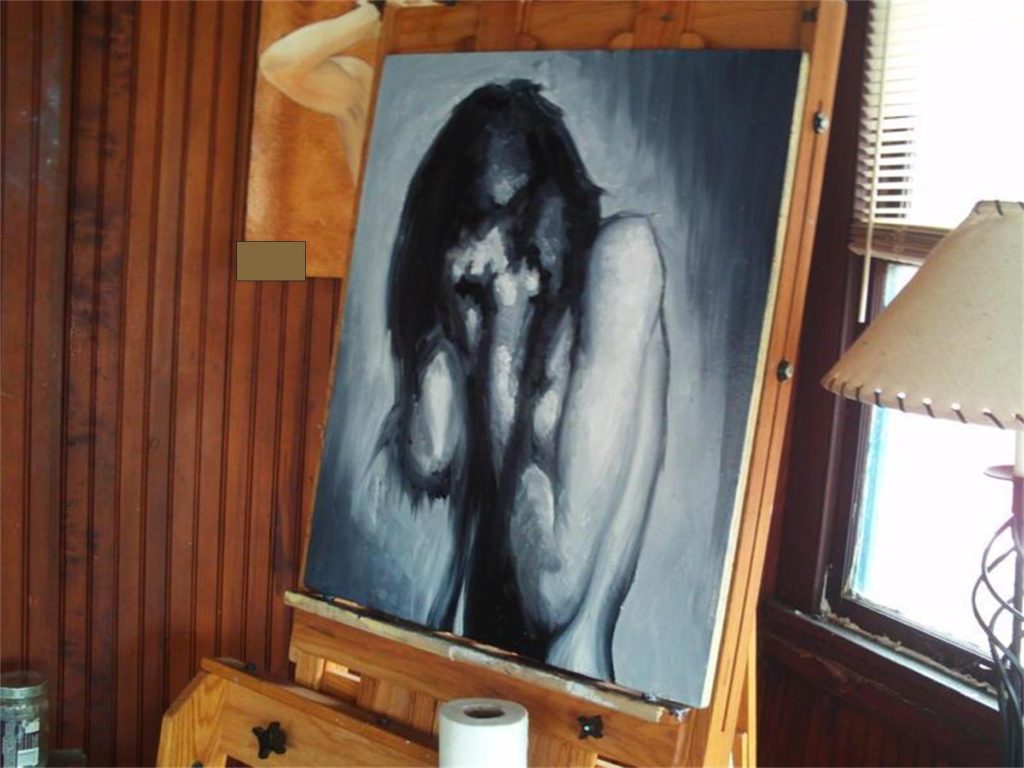
.
Psychopathic systems do not lend longevity to society. Instead they offer a means of destruction.
I aruge that the oligarchy can only continue upon this path that they tred upon by converting everyone to adopt their methodology, or to convert everyone into mindless, emotionless followers.
How about other examples…
"In retrospect, this seems a horrific thing to have done."
Ya. Think?
There are so many examples of great works of art that used to be owned by museums for public enjoyment, but that have been sold off to private collectors. And while some have been repurchased by other museums and are now available for viewing, the battle to obtain these “lost works” was contentious in many cases. We are , and should consider ourselves, to be lucky. Lucky that the oligarchy has allowed us to be able to view these works on the internet. Lucky to be able to recognize that they existed and still exist, and lucky that they were not burned in bonfires of progressive revisionism and fashion.
Examples of artworks that have been sold off…
Let’s look at just some of the art; the paintings that the museums around the world has sold off for the price of a cup of coffee…
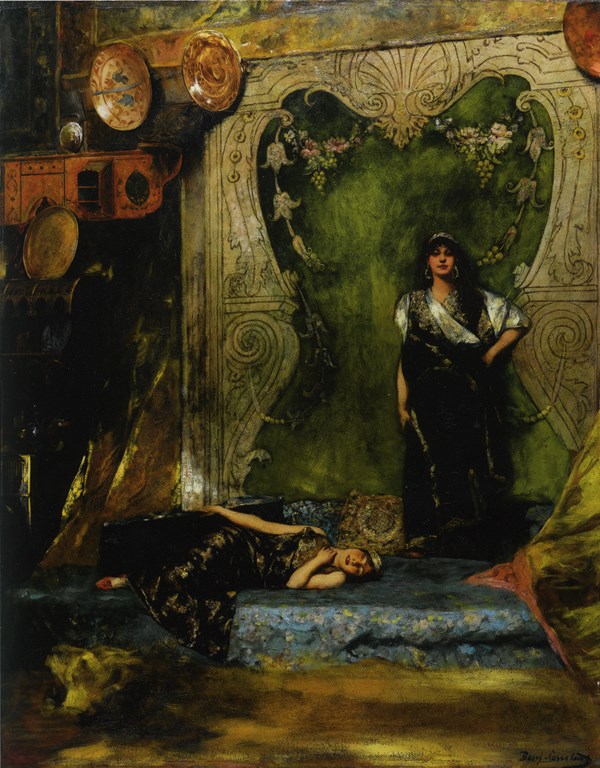
And…
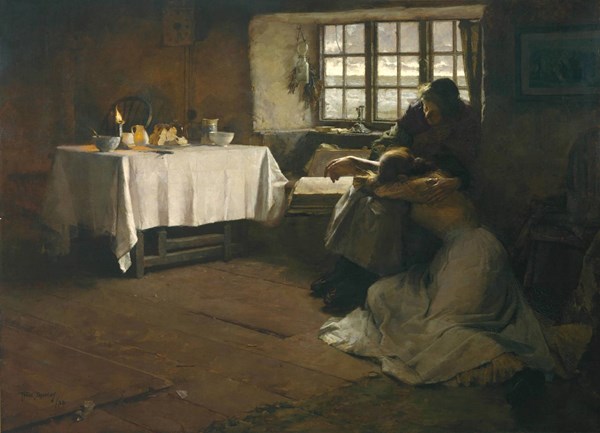
And…

Draper's vision of Icarus, crashed and dead on the rocks, stays true to the myth and yet has a drama to it that is definitely the making of a more contemporary mind. Nearly 50% of the canvas is covered by the image of Icarus' gigantic, broken, dark wings. The wings are so huge they are cut off at the top left of the canvas and at the middle right. This makes the image seem even larger than life. It is as if we look through a window that is not large enough to hold the view. It is possible that the advent of the camera influenced the artist's eye in choosing this unusual perspective. But the impact is successful, dramatic and highly emotional because of the skill in which the wings are painted. They are so huge, in fact, that they make shadows on much of what remains of the canvas. They are so immense and yet they have failed poor Icarus so completely. Icarus lies dead; a darkening figure still strapped to the useless wings, as a sorrowful and sensual nymph pulls his upper torso gentle towards her. Two other nymphs look on woefully. The canvas creates a heart breaking darkness with small splashes of gold light falling on the nymphs and the far rock wall. The golden light is reminiscent of the hope for freedom that Dadelus had once had for his son Icarus. All life, beautiful or not, comes to an end, and all our grand strivings lead us to the same end. The power in this work of art is the sense of loss it projects. If you read the text in the catalogue, it mentions other layers of possible meaning. Simon Toll makes note that Draper's father died shortly before this painting was executed and he suggests that this painting "may also be a private statement of loss." The text also suggests that the painting may be a tribute to the artist Leighton, who died two years earlier. -ARC
And…
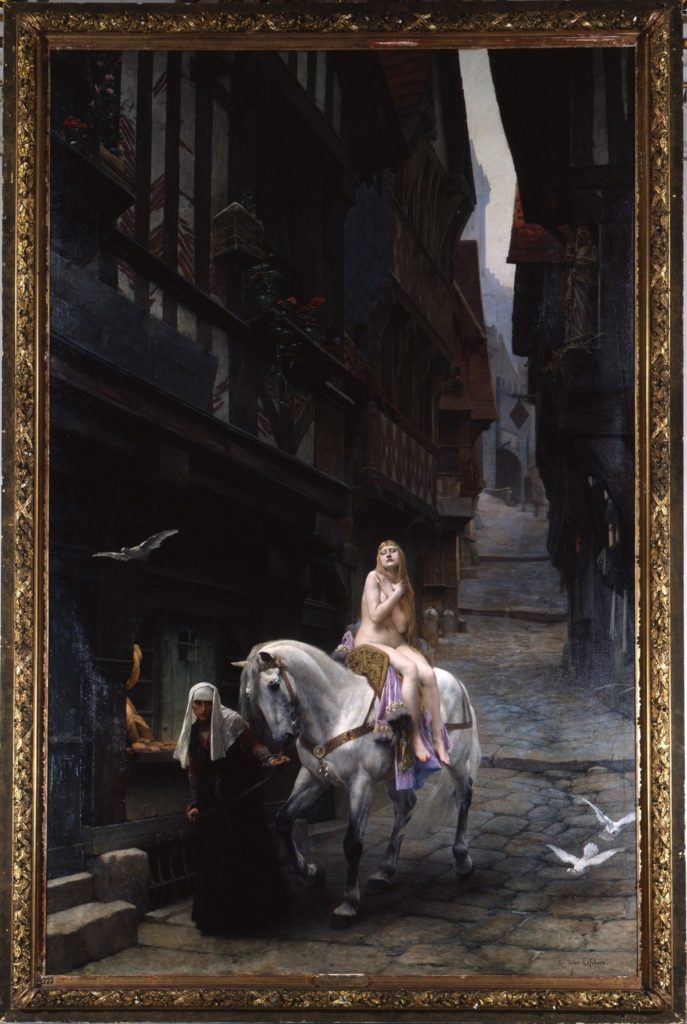
Examples of “art” that have been purchased by museums afterwards…
Let’s have a look at the kinds of art that the museums (all over the world) purchased once they discarded the “old” and “outmoded” art…
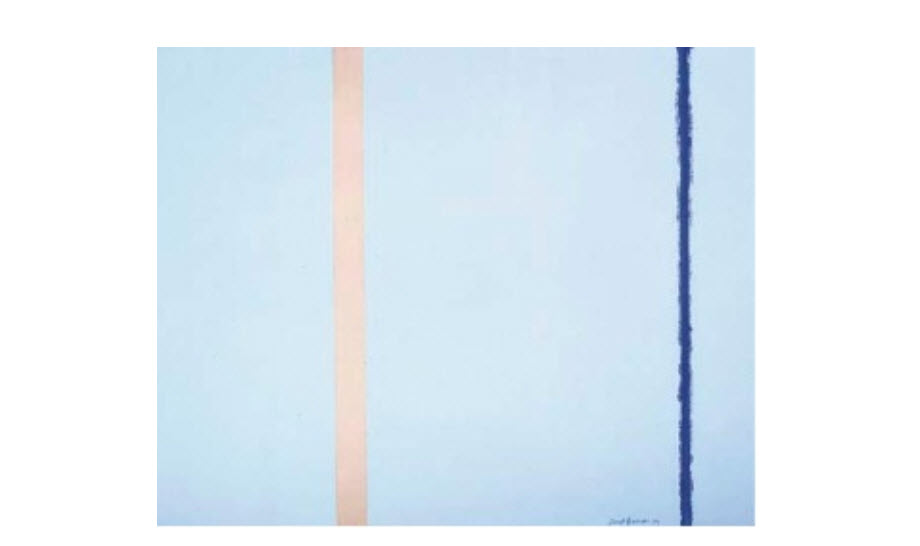
.
Would you believe that this ridiculous-looking canvas was sold for $3.8 million? This abstract painting, which is comprised of two straight lines, was created in 1954. Barnett is an American artist who is a strong follower of abstract expressionism.
Abstract Expressionism, broad movement in American painting that became a dominant trend in Western painting during the 1950s. The movement comprised many styles varying in both technique and quality of expression. Artists include Jackson Pollock, Mark Rothko, Joan Mitchell, and Helen Frankenthaler. -Abstract Expressionism | Definition
This painting, which follows the color field painting style, is one of the few pieces that he has created during his lifetime. Barnett is considered the greatest color field painters of his time. That is the reason why this expensive painting is very popular now.
Or how about a museum considering this to be a worthwhile addition…
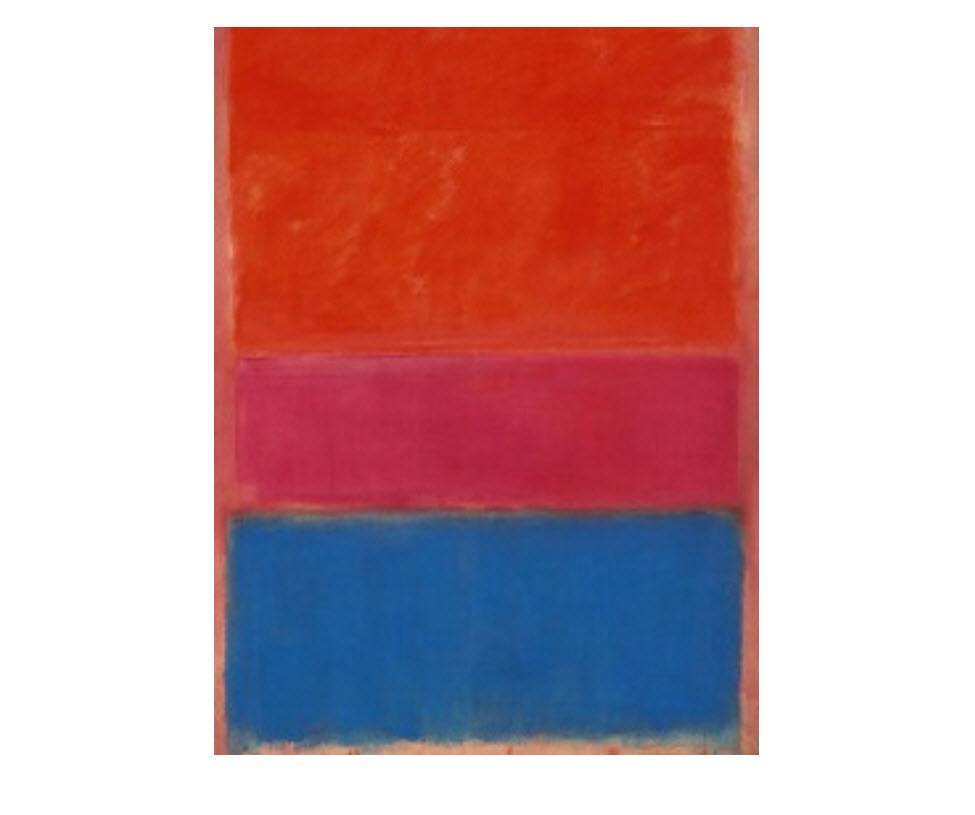
.
This is one of the most basic paintings to date but don’t let its simplicity fool you. It was sold for a whopping $75.1 million during a Sotheby’s auction in November of 2012.
The painter, Mark Rothko, is a known abstract expressionist.
This painting date back 1954 and basically has three blocks of color – and that’s it. Rothko is an American painter with Russian and Jewish Roots. He is known for the color field method style of painting which was popular in New York during the 50’s.
Summary of Color Field Painting Color Field Painting is a tendency within Abstract Expressionism, distinct from gestural abstraction, or Action Painting. It was pioneered in the late 1940s by Mark Rothko, Barnett Newman, and Clyfford Still, who were all independently searching for a style of abstraction that might provide a modern, mythic art and express a yearning for transcendence and the infinite. To achieve this they abandoned all suggestions of figuration and instead exploited the expressive power of color by deploying it in large fields that might envelope the viewer when seen at close quarters. Their work inspired much Post-painterly abstraction, particularly that of Helen Frankenthaler, Morris Louis, Kenneth Noland, and Jules Olitski, though for later color field painters, matters of form tended to be more important than mythic content. -The Art Story
The idea is to paint the canvas with large blocks of solid colors giving off an impression of an uneven surface and a flat plane. This painting pretty much depicts that, although very simplistic that you can imagine a toddler painting this art piece, it has a surprisingly outrageous value.
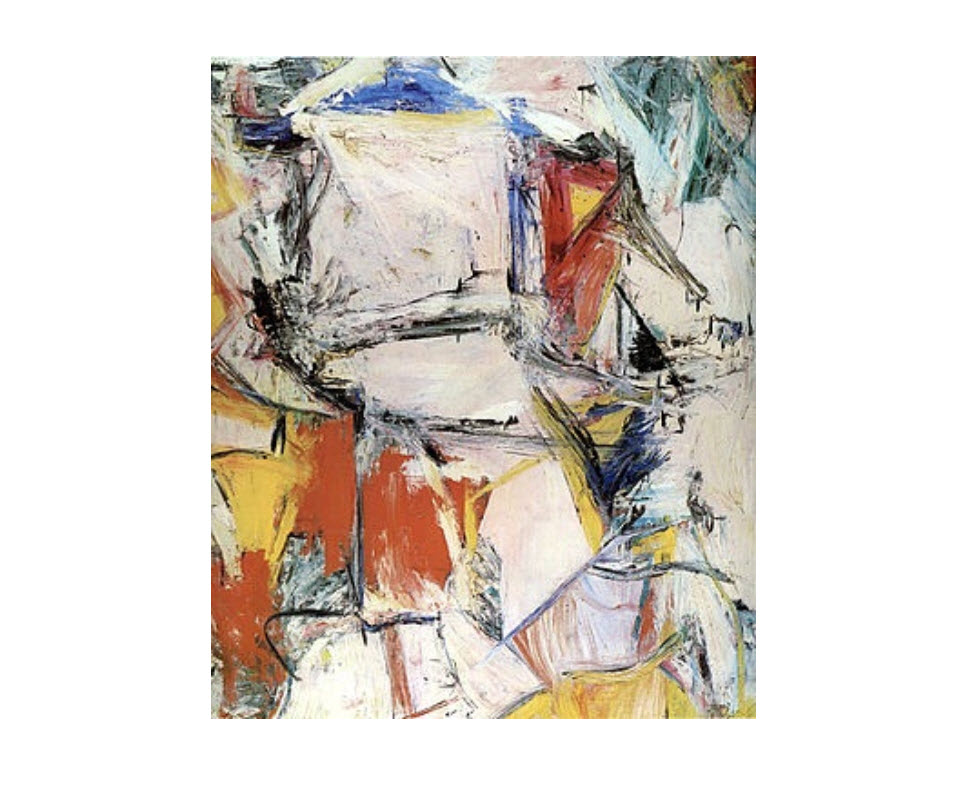
.
To a lot of people, this can be viewed as a real abstract painting with a lot of character in it. There is no doubt about it- but to be valued at $300 million sparks a different kind of conversation.
As with all abstract art, most people can claim they can paint something similar, but in fact, there is more to this painting that meets the eye.
William de Kooning is a New York painter, but is originally from Netherlands. This artwork is an example of ‘action painting’ which is a technique where the artist spontaneously splash paint on canvas versus the traditional painting style that is meticulous and takes time to complete.
Action painting, direct, instinctual, and highly dynamic kind of art that involves the spontaneous application of vigorous, sweeping brushstrokes and the chance effects of dripping and spilling paint onto the canvas. The term was coined by the American art critic Harold Rosenberg to characterize the work of a group of American Abstract Expressionists who utilized the method from about 1950. -Action painting | art | Britannica
It is somehow a form of physical art.
This technique is made popular during the 40’s to 60’s and has coined the concept of abstract expressionism. This painting was made in 1955 and is now housed in the private collection of Kenneth C. Griffin.
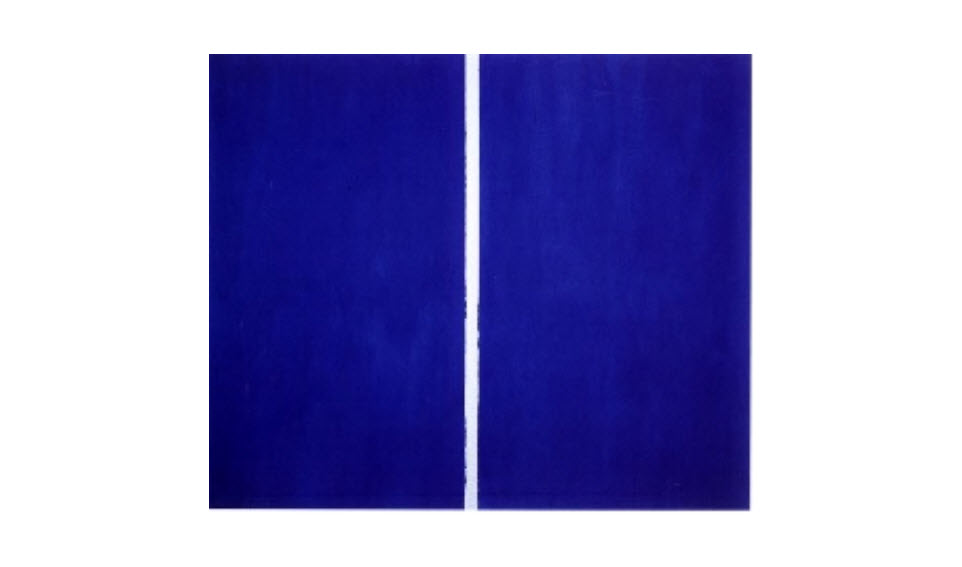
.
This is one of the most boring paintings that you will ever see but you will be surprised to know that this blue colored canvas sold for over $43 million in 2013. It is one of the works of Barnett Newman, a known abstract expressionist. He has done a number of similar paintings such as this and has an entire “Onement” collection, which is basically composed of one dominant color and a division (what he calls a ‘zip’) right smacked in the middle. The zip is used to define the space of his paintings. This New York artist was born in 1905 and has made a following because of his color field art.
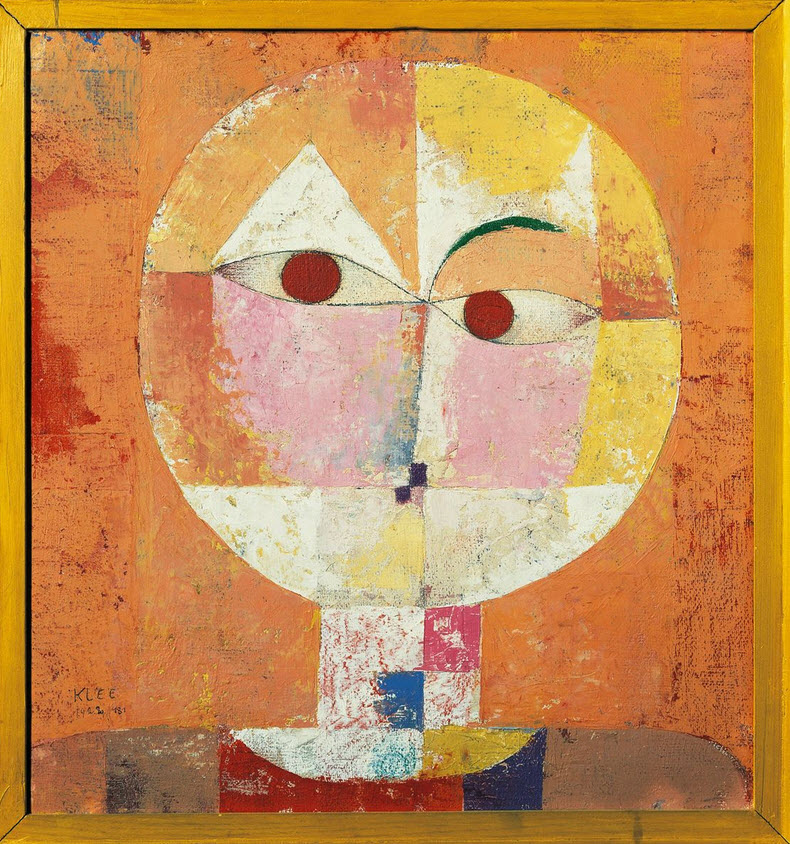
.
If you don’t know better, you might mistake this for a preschooler’s art project. This is actually a painting from the famed painter Paul Klee. It starts off with an odd old maroon color with asymmetrical and disorganized images of triangles and squares, and oh yes, an odd orange circle in off center. One can maybe make this out as a series of houses or even a castle- but, hey, what do we know. Paul Klee is a Swiss-German painter born in 1879. Most of his works are now housed in varied museums all over the globe.

.
If you hear the word ‘painting’ you might be imagining something with a lot of imagination, color gradients and creative imagery. This painting from Kazimir Malevich is far from being complicated or deep but it is one of the most significant work of art to date.
Malevich is actually the pioneer of geometric abstraction- that is pretty obvious with his love of squares and rectangles.
Geometric abstraction, through the Cubist process of purifying art of the vestiges of visual reality, focused on the inherent two-dimensional features of painting. This process of evolving a purely pictorial reality built of elemental geometric forms assumed different stylistic expressions in various European countries and in Russia. -Geometric Abstraction | Essay | The Metropolitan Museum of ...
This artwork was sold in Sotheby’s auction for a staggering $60 million and is the most expensive piece of Russian artwork of all time.

.
To the naked eye, this painting may simply look like a piece of stringy lines splashed around using a yarn, just like those kindergarten art projects kids use to make. This is an artwork done by Jackson Pollock in the year 1948. It is quite a large piece of artwork measuring 8 ft by 4 ft. He is a known abstract expressionist.
This painting in fibreboard uses brown, yellow, white and grey paint. It is often tagged as a dense bird’s nest because of the way the strips of paint overlap each other. This artwork was reported to be sold for over $140 million to a private collector.
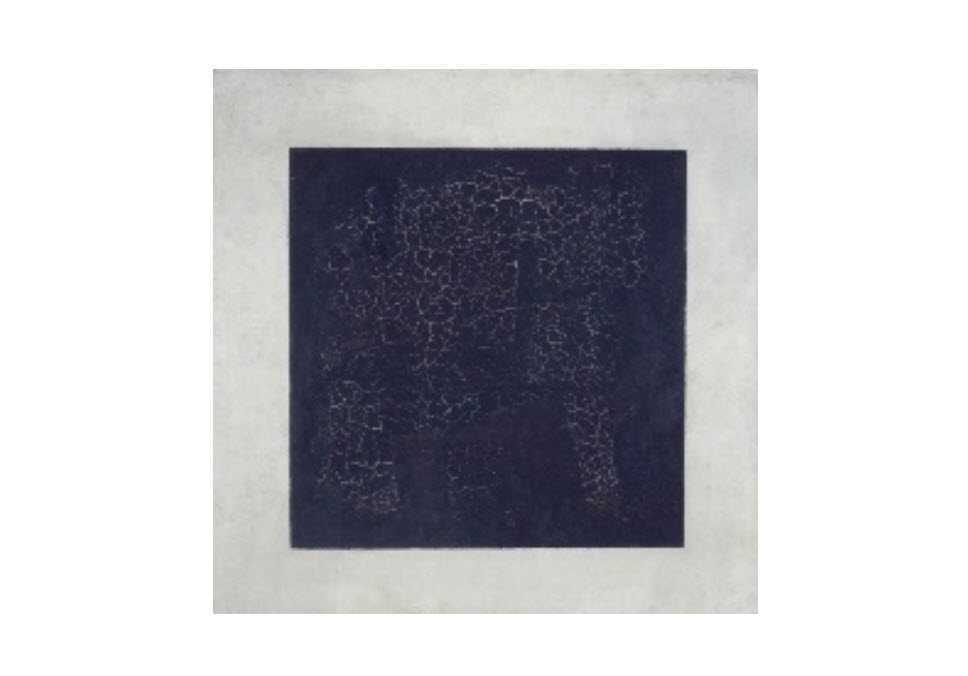
This oil painting was done in oil on linen and is now housed at the Tretyakov Gallery in Moscow. As you would have realized by now, the painting is a mere black square. But there is a lot of philosophy and history behind this seemingly plain and dull painting. This piece is dubbed as the ‘zero point of painting’ and a combination of various art methods including futurism and constructivism. This is one of the prime works of Kazimir Malevich, who is the leader in Russian avant-garde art and has several pieces of similar works under this collection. He described this artwork as ‘liberated nothing’.
Conclusion(s)
One afternoon I toured an art museum while waiting for my husband to finish a business meeting.I was looking forward to a quiet view of the art works. A young couple viewing the paintings ahead of me chatted nonstop between themselves.I watched them a moment and decided the wife was doing all the talk.I admired the husband's patience for putting up with her continuous talk.Distracted by their noise,I moved on. I met with them several times as I moved through the different rooms of art.Each time I heard her constant burst of words,I moved away quickly. I was standing at the counter of the museum gift shop making a purchase when the couple came near to the exit.Before they left,the man reached into his pocket and pulled out a white object.He extended it into a long stick and then tapped his way into the coatroom to get his wife's jacket. "He's a brave man."The clerk at the counter said,"Most of us would give up if wewere blinded at such a young age.During his recovery he made a promise that his life wouldn't change.So ,as before,he and his wife come in whenever there's a new art show." "But what dose he get out of the art?"I asked,"He can't see." "Can't see?You're wrong.He sees a lot.More than you or I do."The clerk said,"His wife describes each painting so he can see it in his head." I learned something about patience,courage and love that day.I saw the patience of a young wife describing paintings to a person without sight and the courage of a husband who would not allow blindness to change his life.And I saw the love shared by two people as I watched this couple walk away hand in hand. -MoFanGe
If you were in the role of the wife (as described above – explaining each painting to her husband), how would you go about describing the more traditional artworks that the museums have sold off? How long would each painting take to describe?
Likewise, how would you describe the new progressive artworks? How long do you think it would take to describe them?
Perhaps this simple measurement, this idea in how to describe the impressions of art that is presented to you, is an element of it’s value and worth. Not that of the amount of currency that is used to purchase it, but rather the emotions and feelings that are generated upon viewing it.
I have argued HERE that the oligarchy is populated with psychopathic individuals that not only are unable to emote, but are unable to feel or express real emotions. Instead they only mimic actions and facial expressions to manipulat others to follow and believe them. As such, these psychopathic individuals see no value in art. Their only value is how they can be used as an element in financial exchange and commerce.
And thus, the study of art, is the study of the oligarchy that rules us.
The oligarchy that rules 99.9% of humans have evolved into a new KIND of human.
They are in possession of a service-for-self sentience, and are extremely good at manipulation, creation and generation of money and currency, as well as the accusition of power as well as the control over others. They are weak in the ability to express emotions and cannot emote. Medically they are known as psychopathic personalities and a healthy society cannot afford to have individuals of this disposition near any positions of power.
As they see no value in the art like “normal” people, they have subverted the institutions that they control; the libraries, the museums, and the art world into something that they understand. They understand money and using objects as trade mediums. They do not conderstand or emote the value of art.
And finally…
This movement towards progressive revisionism can only originate from those that are unable to understand art. They have no idea or concept of evoked emotion via visual stimulation. It is alien to them. They couldn’t understand it in any of it’s myrid forms. Thus…
Indeed, thus…
The entire progressive revisionism movement from art, to culture to society is driven from the oligarchy downward. It is their efforts to redraw the world into a “utopia” that they can understand and embrace.
Do you want more?
I have more posts in my Art index here…
ARTArticles & Links
You’ll not find any big banners or popups here talking about cookies and privacy notices. There are no ads on this site (aside from the hosting ads – a necessary evil). Functionally and fundamentally, I just don’t make money off of this blog. It is NOT monetized. Finally, I don’t track you because I just don’t care to.
To go to the MAIN Index;
Master Index- You can start reading the articles by going HERE.
- You can visit the Index Page HERE to explore by article subject.
- You can also ask the author some questions. You can go HERE to find out how to go about this.
- You can find out more about the author HERE.
- If you have concerns or complaints, you can go HERE.
- If you want to make a donation, you can go HERE.
Please kindly help me out in this effort. There is a lot of effort that goes into this disclosure. I could use all the financial support that anyone could provide. Thank you very much.
[wp_paypal_payment]

